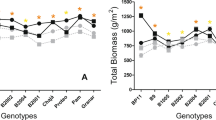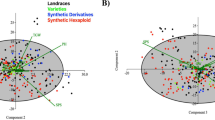Abstract
Drought has significant effect on wheat production by decreasing grain yield. Phenotyping the populations is a useful tool for understanding the interactions between phenotype and genotype. 135 doubled haploid (DH) genotypes and their parental varieties Plainsman (Pl) and Cappelle Desprez (CD) were phenotyped in glasshouse under well-watered (WW) and drought-stress (DS) conditions. The response of plant height, heading time, aboveground biomass, grain yield, root dry mass harvest index (HI) under both conditions, and stress tolerance index (STI) and water consumption in WW conditions was studied. We found 20% decrease in the plant growth, 66% decrease in the aboveground biomass, and 77% decrease in the grain yield. Under WW conditions, high water consumption was not related to high yields, STI, and HI. The tolerant and the sensitive genotypes were selected. In the WW and water consumption treatment, the sensitive genotype group had better grain yield performance, but under DS, the tolerant group had higher grain yield. The average yield loss was 59% in the tolerant group compared to the WW treatment, and the sensitive yield loss was 68%. Correlation was found between the grain yield and root dry mass in the tolerant group. There was significant difference between the tolerant and sensitive groups on water consumption, as the sensitive genotypes had higher water need. We found strong positive correlation between the water consumption and the grain yield in the tolerant group. This study showed that the tolerant genotypes had improved water regulating efficiency.


Similar content being viewed by others
References
Abdolshahi R, Nazari M, Safarian A, Sadathossini TS, Salarpour M, Amiri H (2015) Integrated selection criteria for drought tolerance in wheat (Triticum aestivum L.) breeding programs using discriminant analysis. Field Crops Res 174:20–29
Ayad JY, Al-Abdallat AM, Saoub HM (2010) Variation in root water and nitrogen uptake and their interactive effects on growth and yield of spring wheat and barley genotypes. Int J Bot 6:404–413
Balla K, Karsai I, Kiss T, Bencze S, Bedő Z, Veisz O (2012) Productivity of a doubled haploid winter wheat population under heat stress. Cent Eur J Biol 7(6):1084–1091
Becker SR, Byrne PF, Reid SD, Bauerle WL, McKay JK, Haley SD (2016) Root traits contributing to drought tolerance of synthetic hexaploid wheat in a greenhouse study. Euphytica 207:213–224
Berger B, Parent B, Tester M (2010) High-throughput shoot imaging to study drought responses. J Exp Bot 61:3519–3528
Brown TB, Cheng R, Sirault XR, Rungrat T, Murray KD, Trtilek M (2014) Trait capture: genomic and environment modelling of plant phenomic data. Curr Opin Plant Biol 18:73–79
Cattivelli L, Rizza F, Badeck FW, Mazzucotelli E, Mastrangelo AM, Francia E, Maré C, Tondelli A, Stanca AM (2008) Drought tolerance improvement in crop plants: an integrated view from breeding to genomics. Field Crops Res 112:119–123
Chochois V, Vogel JP, Rebetzke GJ, Watt M (2015) Variation in adult plant phenotypes and partitioning among seed and stem-borne roots across Brachypodium distachyon accessions to exploit in breeding cereals for well-watered and drought environments. Plant Physiol 168(3):953–967
Cob JN, DeClerck G, Greenberg A, Clark R, McCouch S (2013) Next-generation phenotyping: requirements and strategies for enhancing our understanding of genotype-phenotype relationships and its relevance to crop improvement. Theor Appl Genet 126:867–887
Cseri A, Sass L, Törjék O, Pauk J, Vass I, Dudits D (2013) Monitoring drought responses of barley genotypes with semi-robotic phenotyping platform and association analysis between recorded traits and allelic variants of some stress genes. Aust J Crop Sci 7:1560–1570
Donald CM (1962) In search of yield. J Aust Inst Agric Sci 28:171–178
Elazab A, Molero G, Serret MD, Araus JL (2012) Root traits and δ13C and δ18O of durum wheat under different water regimes. Funct Plant Biol 39:379–393
Elazab A, Serret MD, Araus JL (2016) Interactive effect of water and nitrogen regimes on plant growth, root traits and water status of old and modern durum wheat genotypes. Planta 244:125–144
Ellis MH, Bonnett DG, Rebetzke GJ (2007) A 192 bp allele at the Xgwm261 locus is not always associated with the Rht8 dwarfing genes in wheat (Triticum aestivum L.). Euphytica 157:209–214
Fernandez GCJ (1992) Effective selection criteria for assessing plant stress tolerance. In: Kuo CG (ed) Adaptation of food crops to temperature and water stress. Asian Vegetable Research and Development Center, vol 93, no 410. Taiwan Publication, Shanhua, pp 257–270
Fischer R, Edmeades G (2010) Breeding and cereal yield progress. Crop Sci 50:85–98
Fracasso A, Trindade L, Amaducci S (2016) Drought tolerance strategies highlighted by two Sorghum bicolor races in a dry-down experiment. J Plant Physiol 190:1–14
Gaju O, Reynolds MP, Sparkes DL, Mayes S, Ribas-Vargas G, Crossa J, Foulkes MJ (2014) Relationships between physiological traits, grain number and yield potential in a wheat DH population of large spike phenotype. Field Crops Res 164:126–135
Gallé Á, Csiszár J, Secenji M, Guóth A, Cseuz L, Tari I, Györgyey J, Erdei L (2009) Glutathione transferase activity and expression patterns during grain filling in flag leaves of wheat genotypes differing in drought tolerance: response to water deficit. J Plant Physiol 166:1878–1891
García GA, Serrago RA, González FG, Slafer GA, Reynolds MP, Miralles DJ (2014) Wheat grain number: identification of favorable physiological traits in an elite doubled-haploid population. Filed Crops Res 168:26–134
Guóth A, Tari I, Galle A, Csiszar J, Pecsvaradi A, Cseuz L, Erdei L (2009) Comparison of the drought stress responses of tolerant and sensitive wheat cultivars during grain filling: changes in flag leaf photosynthetic activity, ABA levels, and grain yield. J Plant Growth Regul 28:167–176
Hall AJ, Richards RA (2013) Prognosis for genetic improvement of yield potential and water-limited yield of major grain crops. Filed Crops Res 143:18–33
Kocheva KV, Petrov PI, Georgiev GI (2013) Physiological and anatomical responses of wheat to induced dehydration and rehydration. Cent Eur J Biol 8(5):499–503
Lavinsky AO, Magalháes PC, Diniz MM, Gomes-JR CC, Castro EM, Ávila R (2016) Root system traits and its relationship with photosynthesis and productivity in four maize genotypes under drought. Cereal Res Commun 44(1):89–97
Levitt J (1980) Responses of plants to environmental stresses. Water, radiation, salt and other stresses. Academic Press, New York, pp 93–128
Lopes MS, Reynolds M (2011) Drought adaptive traits and wide adaptation in elite lines derived from resynthesized hexaploid wheat. Crop Sci 51:1617–1626
Lopes MS, Reynolds MP, Jalal-Kamali MR, Moussa M, Feltaous Y, Tahi ISA, Barma N, Vargas M, Manners Y, Baum M (2012) The yield correlations of selectable physiological traits in a population of advanced spring wheat lines grown in warm and drought environments. Field Crops Res 128:129–136
Lynch JP, Chimungu JG, Brown KM (2014) Root anatomical phenes associated with water acquisition from drying soil: targets for crop improvement. J Exp Bot 65:6155–6166
Manchadi AM, Christopher J, deVoil P, Hammer G (2006) The role of root architectural traits in adaptation of wheat to water-limited environments. Funct Plant Biol 33:823–837
Mohammadi R (2016) Efficiency of yield-based drought tolerance indices to identify tolerant genotypes in durum wheat. Euphytica 211:71–89
Monneveux P, Jing R, Misra CS (2012) Phenotyping for drought adaptation in wheat using physiological traits. Frontiers Physiol 3:429
Nagel KA, Bonnett D, Furbank R, Walter A, Schurr U, Watt M (2015) Simultaneous effects of leaf irradiance and soil moisture on growth and root system architecture of novel wheat genotypes: implications for phenotyping. J Exp Bot 66(18):5441–5452
Nezhadahmadi A, Prodhan ZH, Faruq G (2013) Drought tolerance in wheat. Sci World J 2013. https://doi.org/10.1155/2013/610721
Parent B, Shahinnia F, Maphosa L, Berger B, Rabie H, Chalmers K, Kovaluch A, Langridge P, Fleury D (2015) Combining field performance with controlled environment plant imaging to identify the genetic control of growth and transpiration underlying yield response to water-deficit stress in wheat. J Exp Bot 66(18):5481–5492
Passioura JB (1983) Roots and drought resistance. Agric Water Manag 7:265–280
Pauk J, Mihály R, Puolimatka M (2003) Protocol for wheat (Triticum aestivum L.) anther culture. In: Kasha K, Maluszynski M (eds) Doubled haploid production in crop plants. Kluwer Academic Publisher, Dordrecht/Boston/London, pp 59–64
Paul K, Pauk J, Deák Z, Sass L, Vass I (2016) Contrasting response of biomass and grain yield to severe drought in Cappelle Desprez and Plainsman V wheat cultivars. PeerJ 4:e1708
Pinto SR, Reynolds MP (2015) Common genetic basis for canopy temperature depression under heat and drought stress associated with optimized root distribution in bread wheat. Theor Appl Genet 128:575–585
Rahman MdM, Chen D, Gillani Z, Klukas C, Chen M (2015) Advanced phenotyping and phenotype data analysis for the study of plant growth and development. Frontiers Plant Sci 6:619
Sahar B, Ahmed B, Naserelhag N, Mohammed J, Harsan O (2016) Efficiency of selection indices in screening bread wheat lines combining drought tolerance and high yield potential. J Plant Breed Crop Sci 8(5):72–86
Tomar RSS, Tiwari S, Vinod Naik BK, Chand S, Deshmukh R et al (2016) Molecular and morpho-agronomical characterization of root architecture at seedling and reproductive stages for drought tolerance in wheat. PLoS One 11(6):e0156528. https://doi.org/10.1371/journal.pone.0156528
Tuberosa R (2012) Phenotyping for drought tolerance of crops in the genomic era. Frontiers in Physiology 3:1–26
Waines JG, Ehdaie B (2007) Domestication and crop physiology: roots of green revolution wheat. Ann Bot 100:991–998
Watt M, Magee LJ, McCully ME (2008) Types, structure and potential for axial water flow in the deepest roots of field-grown cereals. New Phytol 178:135–146
Yang JC, Zhang JH, Wang ZQ, Liu LJ, Zhu QS (2003) Postanthesis water deficits enhance grain filling in two-line hybrid rice. Crop Sci 43:2099–2108
Acknowledgements
This work was supported by Grant of ‘NKFI K 119835’ and GINOP-2.2.1-15-2016-000026. The authors thank Dr. László Cseuz, Sándor Vajasdi-Nagy, Ferenc Markó, and Szilvia Palaticki for their conscientious work. Thanks for the critical reading and English correction of the manuscript to Elizabeth Búza, Dr. Kenny Paul.
Author information
Authors and Affiliations
Corresponding author
Additional information
Communicated by K. Apostol.
Rights and permissions
About this article
Cite this article
Nagy, É., Lantos, C. & Pauk, J. Selection of drought tolerant and sensitive genotypes from wheat DH population. Acta Physiol Plant 39, 261 (2017). https://doi.org/10.1007/s11738-017-2554-y
Received:
Revised:
Accepted:
Published:
DOI: https://doi.org/10.1007/s11738-017-2554-y




